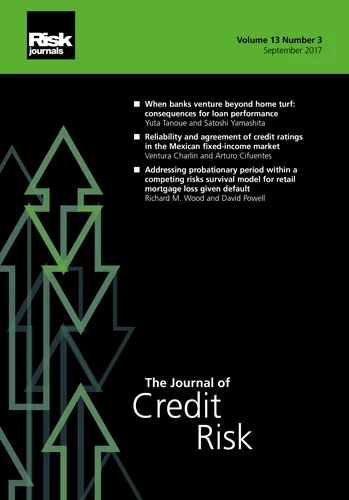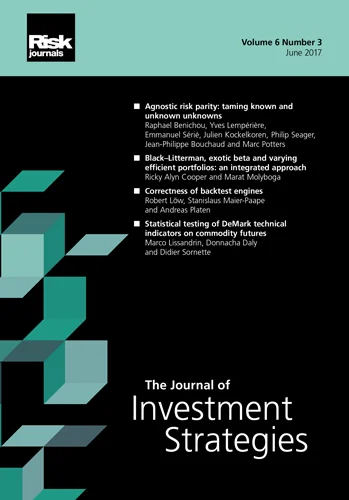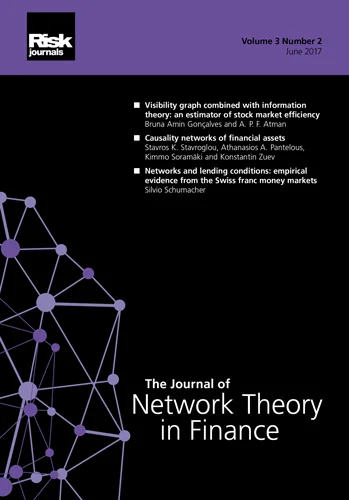Journal of Risk
ISSN:
1465-1211 (print)
1755-2842 (online)
Editor-in-chief: Farid AitSahlia
Volume 8, Number 4 (June 2006)
Editor's Letter
The papers in this issue provide evidence of the breadth of open problems for risk researchers. The papers deal with market and credit risk, portfolio and individual asset risk, and contrast and combine various measures of risk. Each of the papers here opens up promising new lines of risk-related research.
Chabaane, Laurent, Malevergne and Turpin examine the effect of alternative risk measures in portfolio optimization where the portfolio's constituent assets exhibit non-normal returns. They introduce a genetic algorithm which addresses a well-known convexity issue with VARbased efficient frontiers. When their empirical results are taken together, they find that the efficient portfolios are only moderately sensitive to the choice of risk measures, with the greatest differences induced by varying the method of VAR calculation.
Coleman, Li and Henniger take a new look at the problem of constructing an optimal tracking portfolio when the number of assets in the tracking portfolio is constrained. They introduce a technique called graduated non-convexity, which allows them to calculate a sequence of optimal tracking portfolios with an ever decreasing number of constituent assets.
Burkhard and De Giorgi examine default risk in mortgage portfolios employing a hybrid model. Factors that affect default intensity are estimated non-parametrically. Several macroeconomic factors, including employment and interest rates, are found to have significant explanatory power. They also find the loan-to-value ratio to be statistically significant as an explanatory variable for default probabilities.
Venter, de Jongh and Griebenow propose a new model for modeling volatility. In their model volatility evolves according to a mixture of a GARCH process, for intra-day returns, and price shocks that, in effect, accumulate during market closed periods. Their approach yields results that are suggestive about the relationship between GARCH and models of quadratic variation in estimating volatility.
In pursuing any line of research the researcher must make choices about what shall remain exogenous. In part, this reflects a relativist view. Factors are excluded from study that are unlikely to bear significantly on the question at hand and therefore either have little impact or are likely to introduce unnecessary complication. In part, this reflects the decision to adopt a particular paradigm for thinking about a problem. Without imposing such constraints addressing practical research questions becomes almost impossible. That is why, sometimes, it is a good idea to step back from the interesting questions of the moment nd re-examine the fundamental basis of a particular approach. Such re-examination, whether it results in affirmation or a sea-change in thinking, can only be healthy.
Take as an example, portfolio stress-testing in financial risk management. It is generally taken as given that scenario-based stress tests offer a useful method for risk assessment, and the research topics of interest in this area focus largely on implementation questions. Yet the foundation for this belief has never been satisfactorily established. Consider as a contrast the context of portfolio choice problems. Here the Sharpe ratio can be shown to arise from a specific set of assumptions about returns, risk and attitudes toward risk as the natural tool for evaluating alternatives. No such demonstration exists for the use of scenario-based stress tests in the context of risk management.
Fairly simple heuristic arguments suggest that scenario-based stress tests provide very limited useful information about portfolio return distributions, except possibly for portfolios whose risks are very transparent anyway. Research into the foundations of scenario-based stresstesting would therefore provide immediate guidance as to both proper techniques to employ and proper application of the results obtained by such techniques.
Papers in this issue
An intensity-based non-parametric default model for residential mortgage portfolios
Alternative risk measures for alternative investments
Estimation risk in financial risk management: a correction
Operational risk: analytical results when high-severity losses follow a generalized Pareto distribution (GPD) – a note
GARCH-type volatility models based on Brownian inverse Gaussian intra-day return processes
Minimizing tracking error while restricting the number of assets








